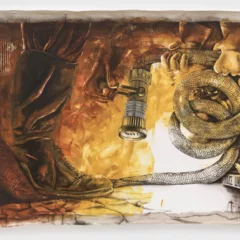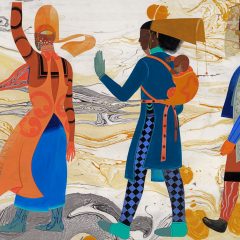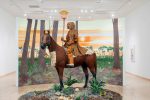Perhaps doll technology has changed, or perhaps it’s been a while since I’ve encountered dolls en-mass, but whatever plastic they were making black baby dolls from in, say, 1988, has a very particular smell that can transport a grown woman back to her childhood bedroom in zero seconds flat. At least that’s what happened to me as I stood before a vast wall of vintage dolls that had been lined up in race-segregated rows at the rear of Trenton Doyle Hancock’s current show, “Moundverse Infants,” at Temple Contemporary. That power of materials to pierce time is in many ways at the heart of Hancock’s practice, as I would come to learn. He was gracious enough to speak with me by phone on the eve of his opening. And where he evaded the more overt racial implications of this body of work, purportedly inspired by the Clark doll test, he reveled in our discussions of serendipity, accumulation and the complexities that hide behind simple forms.
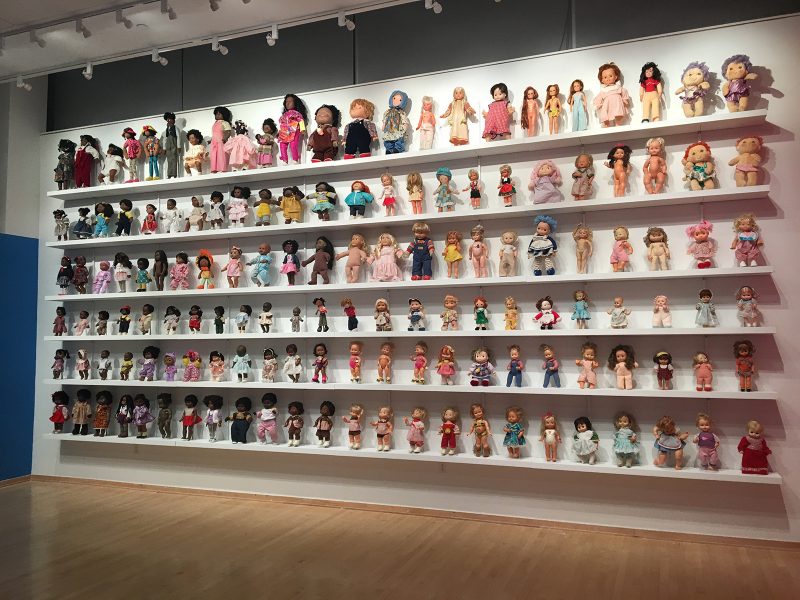
Imani — Part of the exhibition showcases your own doll collection. When and why did you start collecting dolls?
Trenton — I’ve been collecting pretty rigorously for about 20 years and most of my collection is from thrift shops and flea markets. Dolls are probably just 5% of my larger collection of toys. My collecting interest started with me wanting to reclaim toys from my childhood — things that were around me or that I had in the 70s and 80s. That blossomed very organically into an interest in toy history, in looking at the whole scope of toy-making from the 1960s until the early 90s. That was the entry point into me collecting dolls and asking questions about who designed these things, and who they were for.
I don’t actually go out looking for dolls — rather I create rules for myself so that when I’m in a thrift shop and I see a doll from a certain year, I have to buy it. It becomes an experiment where I bring home whatever there is from a certain moment in time. It caps off at about 1990 though, because I don’t feel the design after 1990 is very interesting.
I — Your work has a nostalgic quality in general, both in terms of themes and in terms of the way you harvest materials for new works from previous works. What is your particular interest in childhood nostalgia?
T — It’s multi-layered, but one main component of that interests is the word “Truth.” There is an idea that we are born into a kind of truth and that everything we encounter as children is pure — that at that age, there is no veil between us and “the thing.” I find that purity very interesting, so it makes sense to me to try and reclaim that relationship to discovery of object-hood and ideas. It’s almost as if i’m trying to reconstruct the conditions for that mentality.
I — Have you ever had the experience of interacting with your work around actual children?
T — A show like the one we’re putting on is not meant to appeal to children; that’s never something I think about, actually. If there is one child I’m trying to appeal to, its the child within myself. But perhaps it goes the other direction, and I’m trying to help adults re-access that space which they’ve lost — that interest in discovery and criticality under the veil of play — and to highlight some of the complexities of the things that we think we know.
I can pin something down as cute, but if you look closer, the idea of cuteness or what is wholesome is very perspectival. It changes over the course of generations; it also changes culturally. If I choose dolls, and show as many dolls as possible, underneath the umbrella of that constant there are all of these variations. You also find these entry points to different manufacturers, different areas of the world, different time periods, and different concerns. Underneath something that poses itself as being very simple, there are all of these conflicting and complex ideas being discussed.
I — I see “cuteness” as being very closely related to the presumption of innocence, which is not applied universally across racial and gender lines. To me, the show seems to imply some of those questions about who gets to be innocent. Is that a fair reading?
T — I feel like that is definitely part of it. I welcome whatever people want to bring to the table. As a maker and in terms of my own narrative, I am trying to circumnavigate or barrel through some of those ideas of expected morality and ethics. There’s going to be a Grimm’s fairy tales aspect to the way these things present themselves, but I’m not really trying to teach anybody anything. That’s not my goal. The strangeness of it all is what I’m more interested in.
I want people to come in and go “I normally see this symbol or this image in this place, and it seems to be misplaced, and I don’t know how or why, or what ratio is off.” I want people to come in and try to figure out why these pieces of the puzzle are not fitting together exactly how they’ve been taught that they should. That’s my process, because I like to upend those expectations, even in my own studio.
I — In that vein, there is a lot of typography in the show that bears an uncanny resemblance to logos or trademarks we might know in the real world. Can you talk a bit about your approach to branding?
T — The “Moundverse Infants” logo itself is directly based on the Baby Come Back logo, which was a doll produced in 1976 by Mattel. I basically lifted that font and replaced the text with “Moundverse Infants.” A weird aside is that I contracted with designers who are based in California to format the boxes, and the guy who was actually assigned to the project is the same person who designed the Baby Come Back logo in the 70s as a Mattel employee. There are these weird cosmic occurrences and confluences that let me know I’m on the right track — little rewards along the way that keep things moving.
There is a similar logic with the “Mind of the Mound” logo and the “TDH Properties” logo, which I’ve been using quite a bit for the past three years now. Those appear in all of my paintings, and they are branding. I’m taking on this Warholian aspect of my practice, which is there, but I’m trying to move forward into it, rather than deny it, against all absurdity. And it is sort of absurd, but it also speaks a truth about what we do when we put images out into the world. There’s a fingerprint that we put on them, and sometimes it’s a name written out at the bottom — or in my case, these logos.
I — In the past you’ve talked about the tile pattern that was on your grandmother’s floor, and how you re-discovered it years later and began incorporating it into your collages and paintings. Am I mistaken, or does that same motif show up as the wallpaper for “Moundverse Infants”?
T — The way that came back into my life is another one of those cosmic things. I experienced it in the 1970s and ’80s as my grandmother’s floor. Then in 2010 or ’11 I saw it again, which is when I decided to bring it into my practice as a literal foundation for the paintings. Earlier this year I had an epiphany as we were working on the show at Tyler that ok, I’ve been describing this tile pattern as the thing that binds the Moundverse; I have it as a part of the identity for the doll boxes and the wallpaper that’s in the show. And then something clicked: my grandmother’s name is Alma, and she’s the mother, so it’s like the alma mater, and its a tile pattern so its the alma mater tiler. So I’m like, this is it! I’m meant to be here, back at this cyclical place where I started from.
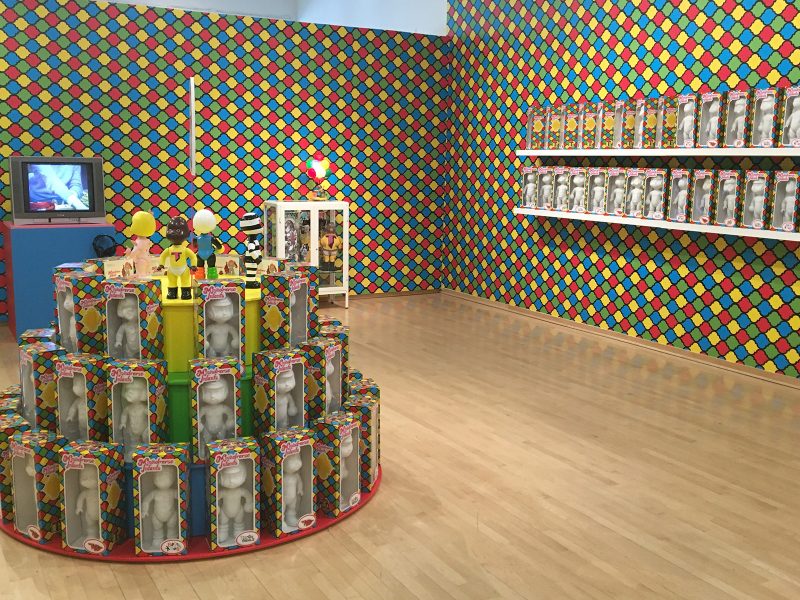
My grandmother is still alive, she’s 96 now, but she’s getting to that place of senility where her mind isn’t there anymore. There’s a slipping away from her, but also a rumination on everything that’s important about where we came from. The show is as much about that as it is about any of the other political ramifications or my surface interest in design or collecting. It’s a very deep kind of thing.
I — This show is called “Moundverse Infants.” What keeps drawing you back to this character and theme of “the mound”?
T — In terms of the fantastical being, this heap covered in fur that lives in the forest, I drew my first one of those a little over 20 years ago in 1997. I started building towards that form even earlier than that, in the mid 90s. I came to know it as a mound in graduate school, here in Philadelphia. It went from being a heap to a hill to a pile to a mound. And when I hit the name mound I said: that’s it! That’s the correct terminology for whatever the heck this form is that I’ve been drawing over and over again.
I was creating other characters at the same time, but they weren’t necessarily connected to the mound form yet. At some point almost immediately after graduate school, I realized that all of these characters must be connected in some way. It was in those connections and in those conversations between forms that the possibility and almost the necessity of narrative presented itself. I realized that the best way to keep tabs on all of these things and chart their growth was through this idea of narrative. There is an aspect of narrative that speaks to material development, and that’s me as a painter, in my studio dealing with materials.
I’ve always had emotional responses to materials. I hate throwing things away, and I hate to see things destroyed, so I keep things around. The idea of mound-ness is a very intuitive and personal way for me to live, because things do tend to pile up around me. I create mounds of information. If you were able to peel back the layers and see into my brain, it would just be a bunch of memories piled into these mound forms. And as much as that is an internal construct, it is external as well; there are mounds of things in my studio. All through the work, in my house, in my car, wherever I am, this theme seems to come up, and I don’t run from it. It’s like, OK, I’m the mound guy now, and I view the world through a mound lens.
I — Have you thought about mounds beyond the context of the mythology you’ve created for them? (In some West African cultures, for example, termite mounds are thought of as portals between the world of the living and the world of the dead).
T — Right now I’m working on a 400-page comic book that charts not only my interest in mound-ness, which arose from an intuitive place within my practice, but tries to make those connections to different cultures where that form has popped up and continues to pop up. I’m starting to reach out and look at different architectural developments like igloos and huts and pyramids even, thinking about that architectural angle of repose, if you will, and why its ergonomically fit for humanity. I’m also thinking about tombs and other spiritual connotations of the form. I don’t claim ownership of this form. I’m one little spot in mound-ness, but it’s as if I’ve found my community. There’s lots more to be learned.
I — One dimension of dolls (and of toys in general) that we haven’t touched upon is that they invite action. When you were designing dolls for the show, did you think of them as static objects or as objects that engage narrative through play?
T — There’s a narrative component, but it’s also playing itself out in physical space. It’s actually a very meta thing, because in the storyline that I’ve been working on for the past 4-5 years, the Trenton Doyle Hancock character is kidnapped by the Bringbacks and taken to this mound which basically consumes him. There is this period of transformation or transmogrification and he enters another plane where time doubles back on itself. Ultimately it’s revealed that the Hancock character has been recruited into the Moundverse because of his interest in toy design and painting and being a creative being. So these Moundverse ambassadors have decided to transform him into a Bringback so that he can create toys for the cause of furthering the Moundverse and its history for future generations.
I’m interested in this idea that object-hood is what lasts well beyond our physical, material experience — that there are going to be these plastic objects that out-live us. There are going to be these landfills, these mounds of things that are still around, and I’m contributing to that accumulation by making toys. In a way it’s also me talking about the mechanism of collecting and the mentality required to hunt and gather these things. That I am at once a creator and a collector of the thing describes my process. As you mentioned earlier, I am constantly cannibalizing earlier iterations of my own work, which is just me taking that next step.



